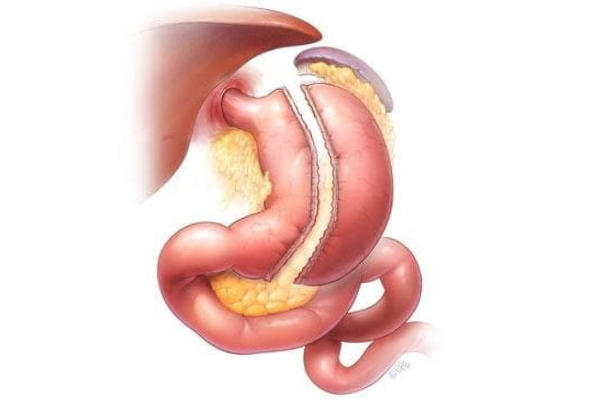
Sleeve Gastrectomy
What is Sleeve Gastrectomy?
Sleeve gastrectomy is the removal of large part of the stomach which serves as storage of the stomach. This way, the stomach which has a volume of 1.5-2 litres is transformed into a thin tube with a volume of 50-150 ml. In this technique, the amount of the food which can be taken at a time is reduced but the natural course of the digestive system is intervened. This operation is performed through laparoscopic method, namely using 4 to 5 small incisions near the belly button. The operation takes about 45 to 75 minutes. The length of stay in hospital is usually 2 to 3 days.
The main advantages of the sleeve gastrectomy are that it does not change the natural course of the digestion system. Therefore leading less deficiency of vitamin and mineral, the incidence of Dumping syndrome is lower. It is less probable to lead the reflux complaint, and that not foreign object is inserted in the body. However, it has some disadvantages, which mainly include reflux, existence of a long stapler line (bleeding and leakage through stapler line) and irreversibility. In other words, the side effects of sleeve gastrectomy are less compared to the gastric bypass and the larger operations.
The Package Includes:
- Doctor Fees for first and follow-up examinations
- Orthopedic Surgeon fees w. assistant surgeon
- Pre-op consultation with anesthesiologist, endocrinology, pulmonology, cardiology, nutrition specialist and psychologist, bloodwork, ECG, cardiac echo and lung graphy
- Pre-op gastroscopy and abdomen ultrasound
- Operating Room Charges
- Accomodation for up to 3 nights in the surgical floor including; Standard Room, Nursing Service Charges, Regular Menu Food Charges for patient and 1 accompanying person.
- Medical equipment and supplies for the procedure and procedure-related medications
- E-consultation with the surgeon in the post-up period in the home country
How does sleeve gastrectomy work?
During the procedure, almost 80 % of the stomach is removed leaving a narrow gastric tube. This way, the amount of the food which can be taken is significantly reduced and one feels full quickly. This is the restrictive effect of the operation. However, the part removed during the sleeve gastrectomy is the part producing the Ghrelin hormone which triggers the hunger. The removal of this part reduces the amount of the hormone triggering the hunger in blood, usually diminishing the appetite. This also accounts for the metabolic and hormonal effects of this operation. As the natural course of the digestive system is not intervened, the digestion and absorption normally continues after the sleeve gastrectomy. Thus, there is lower risk of vitamin and mineral deficiency.
How much weight is lost after sleeve gastrectomy?
Obesity is a complicated problem, which is not only an imbalance of caloric intake and calories burnt. Obesity has many underlying hormonal mechanisms. When sleeve gastrectomy is supported with a healthy diet and exercise, it enables the loss of 60 to 80% of the overweight over one or two years following the operation. However, there is a risk of inability to lose adequate weight or even re-gaining weight when the rules are not obeyed and the old bad habits are back.
What is the recovery period after surgery?
About 7-10 days. Therefore, we recommend dietitian and psychologist follow up to our patients for at least 2 years after surgery.
Robot-Assisted Obesity Surgery
Surgical treatment is the most effective treatment method with proven effectiveness in the treatment of severe obesity patients and treatment-resistant type 2 diabetes patients. All obesity and metabolic surgery operations can be performed with minimally invasive methods (laparoscopic and robotic).
ROBOT-ASSISTED SURGERY, which is not available in every center and can only be used by a small number of surgeons, is superior to laparoscopic surgery in many ways. Robotic surgery is a surgical technique that can use techniques and equipment that minimally damage tissues in surgical interventions. Robotic surgery has all the benefits of laparoscopic surgery, such as less pain, short hospital stay, and good cosmetic results. The cosmetic results of robotic surgery are excellent.
Robotic surgery can also be considered as an advanced laparoscopic surgery. The basic operating principles are similar to laparoscopic surgery. First, 4-5 8 mm holes are opened in the abdominal wall and the abdomen is inflated with carbon dioxide gas to create an area for the study. Then, special robotic arms, which are specially designed for robotic surgery and prevent damage to the abdominal wall, are attached to these holes.
Surgery is performed with the help of these arms with high mobility. A high-resolution camera is attached to one of the holes and this camera transmits the surgical images both to the console where the surgeon performs the operation and to a large monitor located at the head of the operating bed. After this stage, the 1st surgeon leaves his place to an experienced assistant, goes to a special console designed for him, and performs the surgery with the commands he gives from there. The surgical console is the unit where all the settings related to the robot are made.
Benefits
The surgeon performs the surgery using special hand tools. The movements of the surgeon are reflected in the arms of the robot. Furthermore, the surgery is performed thanks to the fine movements of the robot arms and the ability to work easily in narrow spaces.
The three-dimensional and high-quality image of the robotic camera gives the surgeon the feeling of operating with his naked eyes. In fact, thanks to the magnified image, it allows to see more clearly even the structures that the human eye can hardly see. The wrist part of the robotic arms has the ability to work similarly to the human wrist. In fact, with its high degree of mobility, it has more mobility than the human wrist. Even in tight spaces, many difficult surgical procedures can be easily performed with the robot thanks to this mobility. Since these instruments are also powerful instruments, they provide ease of operation, especially in overweight (obese) patients. With all the above-mentioned features, robotic surgery enables the surgeon to perform surgical procedures with high accuracy. Moreover, it performs with high precision.
To sum up, robotic surgery, which offers all the possibilities of modern technology, can be safely used in the surgical treatment of morbid obesity and type 2 diabetes.
The Package Includes:
- Doctor Fees for first and follow-up examinations
- Orthopedic Surgeon fees w. assistant surgeon
- Pre-op consultation with anesthesiologist, endocrinology, pulmonology, cardiology, nutrition specialist and psychologist, bloodwork, ECG, cardiac echo and lung graphy
- Pre-op gastroscopy and abdomen ultrasound
- Operating Room Charges
- Accomodation for up to 3 nights in the surgical floor including; Standard Room, Nursing Service Charges, Regular Menu Food Charges for patient and 1 accompanying person.
- Medical equipment and supplies for the procedure and procedure-related medications
- E-consultation with the surgeon in the post-up period in the home country
Doctor Involved In: Abdulcabbar Kartal

